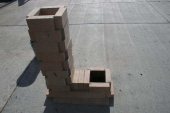
 4
4








Success has a Thousand Fathers , Failure is an Orphan
LOOK AT THE " SIMILAR THREADS " BELOW !
 1
1




regards, Peter
 1
1














Success has a Thousand Fathers , Failure is an Orphan
LOOK AT THE " SIMILAR THREADS " BELOW !
 1
1












 1
1




Baxter Tidwell wrote:The outdoor chimney is five feet long with a simple rain cap on it. I agree that the exit temperature seems high. I can think of three reasons for this. First, the probe is about a foot inside the top of the chimney. So it'll read a bit hotter than directly at the end of the exhaust. Second, these temperatures were read when there was only about five feet of bench mass, and that was at the beginning. The uncovered vent for the rest of the run was very hot. I would assume that when the entire mass is in place, the temperature will be a lot cooler.
Baxter Tidwell wrote:There is a gap between the outer barrel and the concrete. I didn't want to go against the drum with concrete as the type of concrete I was using tends to fail at around 600 degrees. I was planning on covering that with high-temperature fire clay, but I'll probably just leave it open.
Baxter Tidwell wrote:There's a two-inch gap between the top of the riser and the top of the top barrel.
regards, Peter
 1
1
















Jon Kennedy wrote: I have a question, where does your fresh air come from?




Baxter Tidwell wrote:
Fresh air is no problem, unfortunately. The shop is three 40-ft steel shipping containers welded together. It is very difficult to get everything air-tight, especially around doors and windows. There's always a draft somewhere.
But that's not a problem because it's a workshop, and you'd expect it to be drafty. Maybe this winter I'll want to seal it up a bit more if it's uncomfortable. If that causes a constriction in airflow, perhaps I can punch a hole in the outside wall next to the heater core and let in some fresh air. I'll figure it out as I go along.
When I build a RMH in the house next year, I'll have to deal with that question. I have some ideas, but I'll have to do some more research and experimentation.
 ). I would like to see how heat reflectors would affect things too. Heat radiated to roof (for example) could be reflected down to where it could do some more good, or angled to hit people's backside. As a bonus these surfaces might disperse sound waves for a less "ringy" room.
). I would like to see how heat reflectors would affect things too. Heat radiated to roof (for example) could be reflected down to where it could do some more good, or angled to hit people's backside. As a bonus these surfaces might disperse sound waves for a less "ringy" room. 
 1
1




 1
1




Baxter Tidwell wrote:
Fresh air is no problem, unfortunately. The shop is three 40-ft steel shipping containers welded together. It is very difficult to get everything air-tight, especially around doors and windows. There's always a draft somewhere.
But that's not a problem because it's a workshop, and you'd expect it to be drafty. Maybe this winter I'll want to seal it up a bit more if it's uncomfortable. If that causes a constriction in airflow, perhaps I can punch a hole in the outside wall next to the heater core and let in some fresh air. I'll figure it out as I go along.
 2
2




A human being should be able to change a diaper, plan an invasion, butcher a hog, conn a ship, design a building, write a sonnet, balance accounts, build a wall, set a bone, comfort the dying, take orders, give orders, cooperate, act alone, solve equations, analyze a new problem, pitch manure, program a computer, cook a tasty meal, fight efficiently, die gallantly. Specialization is for insects.
-Robert A. Heinlein








 2
2




allen lumley wrote: Baxter T. : W.O.W., all I can say is a Big Welcome to PERMIES, and the Permies Rocket Stove Forum/Threads! The sensors are a thing that has been talked to death
without anyone actually doing any thing about it ! If you had to duplicate the sensors and the arduino system to make it compatible with a lap top what do you think it
would cost?
After I have a chance to take this all in, I will probably be back with a dozen questions ! Again just as one member to another welcome. For the Craft! Pyro AL

|
We begin by testing your absorbancy by exposing you to this tiny ad:
Rocket Mass Heater Resources Wiki
https://permies.com/w/rmh-resources
|







